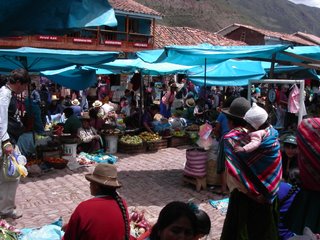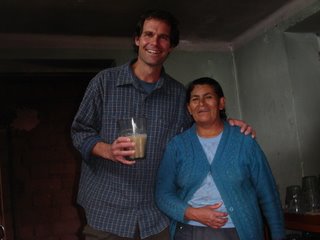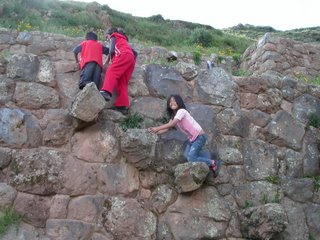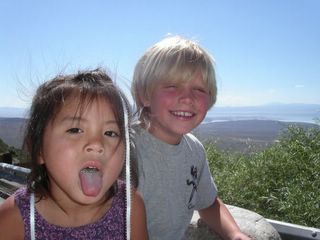Pisac Market and Ruins



Recently, we went to the nearby town of Pisac which hosts a large market on Sundays. Although somewhat touristy, the central square of the market was still largely populated by local women from the surrounding area who had come to sell their wares and buy supplies. They largely wore the traditional Andean dress of bowler hats (either white or brown), large black braids, brightly colored shawls, and skirts. The market fills the plaza outside of the small church which was also very interesting. The inside of the church was covered with murals in shades of purple and blue and yellow and featured various biblical depictions with a Peruvian slant. For instance, instead of holding a baby sheep, Jesus is shown holding a baby llama. Instead of the standard European depictions of biblical characters, these were depicted with more mestizo faces (which is probably closer to what was actually the skin color of the people in the holy land at the time of Jesus).
After the market and a late brunch, we drove up to the ruins. The Incan road, what we would call a hiking path, to the central ruins displayed the ingenuity and skill of Incan road building skills in a short kilometer or so. The trail traversed across buttresses seemingly glued to the side of a cliff, went through a tunnel that had been widened through the cliff itself and went up and down numerous steep stairways and through various defensive constructions. Maya was a bit tired by this time so I carried her on my shoulders which seemed to revive her. Zak loved the hike and although Grandma Carol wouldn’t use the same adjective, she did use the word “exhilarating” once she was back home and was no longer afraid of falling over the side of the cliff. The ruins themselves were quite amazing; incredible Incan stonework with commanding views of the Sacred Valley below. The central area of the ruins featured a Intihuatana, a natural stone pillar sticking up out of a large black rock that served as a “hitching post for the sun”. Given its prominent position, one could almost imagine it serving as just that. After all, aren’t different belief systems just that: a system of beliefs? A hitching post to the sun doesn’t sound that much more farfetched than a young girl impregnated by angels or Mohammed riding to heaven on a horse or Joseph Smith being directed by an angel to gold tablets that were only legible when looked at through a special stone. So, if you believe in those things, why not a hitching post to the sun? After all it still works, the sun has not pulled away from its tether yet.
Although I am a social scientist by trade, I enjoy working with my hands and am somewhat of a frustrated (others might say frustrating) craftsman and I really appreciated the exquisite masonry work of the surrounding buildings, altars, and ceremonial baths; massive stone blocks set together so precisely, and without any grout, that when you run your fingers over them, you cannot tell where one begins and the other ends. The areas is fed by springs which continue to flow through the channels and baths carved by the Incas. We pretty much had the place to ourselves – there’s not a lot of that roped off “you can look but not touch” kind of mentality down here – and I considered taking a little dip both because I love water in the outdoors and because I was curious if there wasn’t still a bit of that Incan magic resonating in the pools, but we weren’t completely alone and it was getting late so we decided to head back.
While the word of the day at Tipon was water, here it was terraces. A thousand feet of terraces curved gracefully around the hill below the ceremonial ruins. The terraces were designed to maximize sunlight and facilitate irrigation but, in addition to their functional uses, they appealed to the aesthetic sensibilities of both the Incas and those of us who have come along much later to appreciate their work. The terraces are largely unbroken by steps, which take up agriculture space and promote erosion, instead access to one level or another is gained by flagstone steps set into the walls along a diagonal, as at Tipón. On either side of the mountain, there are two large Incan cemeteries. One can still see a large number of holes pock marking the cliffs which were plundered by grave robbers before they could be examined by archeologists. From the valley below, the terracing system was designed to accentuate the natural features of the mountain so that the entire side of the mountain was made to resemble a giant condor about to take flight. Because of its majestic size, the condor is the largest bird in the world, and because it feeds on carrion and lives at the top of the highest crags, the Andean people believe(d) that the condor was the messenger of the sun and carried the spirits of the dead on to the next world, so perhaps the empty graves aren’t the result of grave robbers after all? I guess it largely depends on what you care to believe in.




















